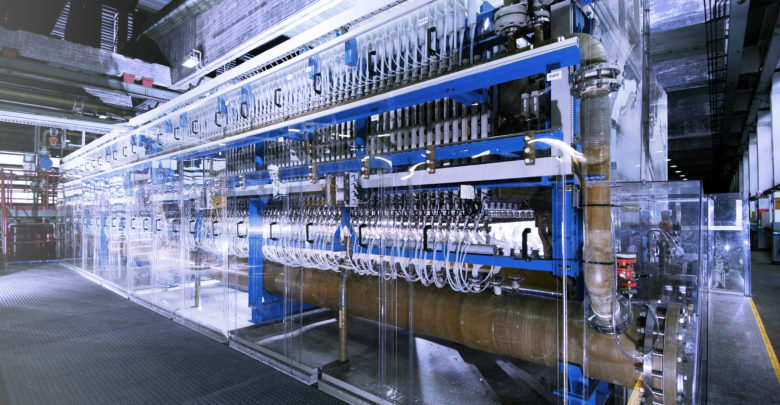More output with low energy consumption
ThyssenKrupp enhances electrolysis technology for chlorine production

- A decisive contribution to more environmentally-friendly and cost-effective chlorine production: advanced oxygen depolarized cathode (ODC) technology enables 50 percent more output and significantly lower investment costs
- The energy-saving process to be utilized for a new chlorine production plant in Spain
Around 70 percent of all chemical products use chlorine in their manufacturing process. At the same time, the production of this important base chemical is one of the most energy-intensive processes in the chemical industry. In order to change that, thyssenkrupp is offering the NaCl-ODC electrolysis technology (ODC = oxygen depolarized cathode) which lowers power consumption and indirect CO2 emissions by up to 25 percent compared to standard production processes.
Engineers from thyssenkrupp have now been able to develop the technology even further: By raising the current density of the electrolyzer from 4 to 6 kilo amperes, output was increased by 50 percent. Electrolyzers with the same output capacity can now be built about one third smaller, resulting in significantly lower total cost of ownership. Plant operators profit from a smaller plant footprint, lower maintenance and from the generally high efficiency that comes with the NaCl-ODC electrolysis process.
Advanced ODC technology reduces carbon footprint of chlorine production plants
thyssenkrupp’s cooperation partner Covestro will be the first to utilize the advanced ODC electrolysis for a new chlor-alkali plant in Tarragona, Spain. “Three factors played a vital role in choosing the technology for our process: sustainability, energy efficiency, and increasing our site’s competitiveness”, states Dr. Klaus Schäfer, Chief Technology Officer at Covestro.
Energy consumption makes up roughly one third of the operating expenses of a chlor-alkali production plant. Thus, the advanced NaCl-ODC technology helps to significantly reduce energy costs. Compared with the conventional single-element design, it will cut CO2 emissions of the Tarragona plant by around 22,000 metric tons per year. That’s roughly the amount produced by 15,000 cars in one year. Implementation of NaCl-ODC electrolysis as standard technology for chlorine production around the world would mean an energy saving potential of 35 million megawatt hours per year.
Cost-efficient solution for the chlor-alkali industry
The original NaCl-ODC electrolysis was developed by combining two key technologies: The oxygen-depolarized cathodes developed by Covestro were integrated into the electrolysis cells (single element technology) from thyssenkrupp Uhde Chlorine Engineers. By introducing oxygen into the cathode, the often unwanted formation of hydrogen is suppressed. The reaction is comparable to fuel cells, but here it lowers the electrical energy consumption instead of producing energy. This enables huge energy savings, which are highest when oxygen is available on site.
thyssenkrupp successfully commissioned the first large-scale reference for this technology at the end of 2015 for BEFAR Group in China. Denis Krude, CEO of thyssenkrupp Uhde Chlorine Engineers: “Customers expect us to supply solutions that are viable, future-proof and at the same time environmentally friendly. Our energy-saving ODC technology can make a key contribution to the competitiveness of our customers in the chemical industry. The first large-scale plant in China successfully demonstrated that the technology makes chlorine production much more eco-friendly and cost-efficient.”
As energy prices are on the rise and sustainability targets become more and more important, NaCl-ODC is an increasingly attractive option for future competitiveness in the chlor-alkali market. As it is based on the general design of the single element technology, integration of this technology into existing plants can be done easily. Cell size and brine circulation are 100 percent compatible. Plant owners can easily upgrade existing infrastructures either to lower electricity consumption, or to increase their production capacity without needing additional space or a new build.


